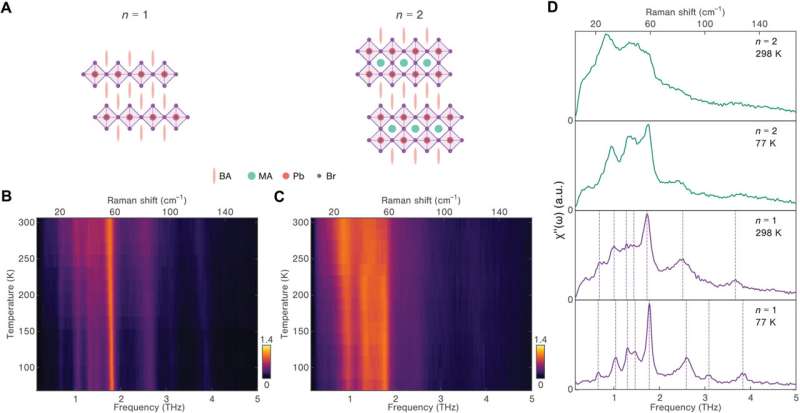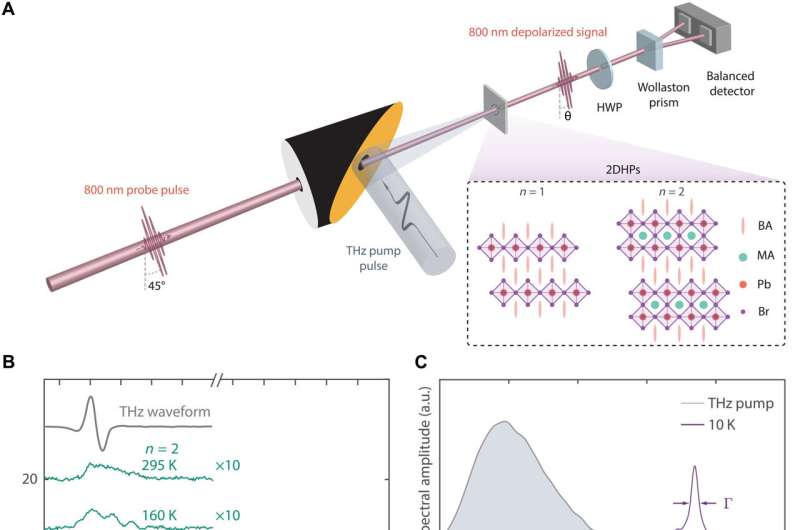August 31, 2023 feature
This article has been reviewed according to Science X's editorial process and policies. Editors have highlighted the following attributes while ensuring the content's credibility:
fact-checked
peer-reviewed publication
trusted source
proofread
Discovering enhanced lattice dynamics in a single-layered hybrid perovskite

Layered hybrid perovskites show diverse physical properties and exceptional functionality; however, from a materials science viewpoint, the co-existence of lattice order and structural disorder can hinder the understanding of such materials. Lattice dynamics can be affected by dimensional engineering of inorganic frameworks and interactions with molecular moieties in a process that remains unknown.
To address this problem, Zhuquan Zhang and a team of scientists in chemistry and physics at the University of Pennsylvania, University of Texas, Austin, and the Massachusetts Institute of Technology, U.S., used a combination of spontaneous Raman scattering, terahertz spectroscopy and molecular dynamics simulations.
The research outcomes revealed how the structural dynamics in and out of equilibrium provided unexpected observables to differentiate single- and double-layered perovskites. The study is published in Science Advances.
While they did not observe vibrational coherence in double-layered perovskites, they noted the possibility for an off-resonant terahertz pulse to drive a long-lived coherent phonon mode in the single-layered system. Based on layered perovskites, the outcomes resulted in ultrafast structural engineering and high-speed optical modulators.
Hybrid perovskites
In the past two decades, materials scientists have shown the precedence of two-dimensional hybrid perovskites as natural, quantum-well-like semiconductors with marked light absorption, large luminescence quantum yield and strong exciton binding energy. These materials have a wide-range of chemical variability and structural diversity when compared to their 3D counterparts, and their composition can be tuned by altering organic spacer cations, inorganic networks and octahedral layers.
The layers can also provide a plethora of emergent properties, which include ferroelectricity, spin selectivity and multifunctionality that can be understood by the interplay between the inorganic lattice framework and organic cations that are key to this goal.
Researchers had previously conducted mechanistic studies to reveal how the features of hybrid lattices are in conjunction with structural disorder. However, it remains to be determined if these properties can persist to the single-layer limit.
In this new work, Zhang and colleagues presented a joint experimental and theoretical study to uncover the origin of the structural complexity of two-dimensional (2D) hybrid perovskites. They used steady state and ultrafast experiments to identify unique fingerprints to distinguish the structural dynamics of hybrid lattices in the crossover from quasi-2D to 2D. The team rationalized the research outcomes by using calculations of molecular dynamics at an atomic level to understand the hybrid lattice in and out of equilibrium.

The experiments
The team focused on two prototypical two-dimensional hybrid perovskites that differed in the number of corner-shaping octahedral layers. One variant contained organic spacer ligands to separate the octahedral layers, while the double-layered hybrid perovskite contained additional A-site cations that occupied cuboctahedral pockets formed by eight octahedra.
The team used spontaneous Raman scattering to monitor low-energy collective responses and structural disorder to thereby study lattice dynamics in thermal equilibrium. The scientists characterized the Raman spectra, then based on the steady-state Raman data they formed a thermal equilibrium view of the structural complexity in two-dimensional hybrid perovskites to show a sizably reduced structural disorder.
The Raman data highlighted the behavior of bromide hybrid perovskites to be in stark contrast to the iodide 2D hybrid perovskites to establish a benchmark comparison of octahedral dynamics that transitioned from the double-layer to the single-layer structure.
Time evolution of the lattice response and molecular dynamics simulations.
The team then traced the time evolution of the lattice response at ultrafast timescales to gain additional insights to the structural dynamics and separated the collective modes from dynamic disorder. Using optical Kerr effect spectroscopy, Zhang and the team studied lattice and molecular reorientation dynamics in hybrid perovskites. The signals were substantially affected by the nonlinear effect of light propagation.
Then by using terahertz field induced Kerr-effect spectroscopy, they monitored the lattice behavior in real-time to provide several advantages; for instance, the terahertz frequency photons matched the natural energy scale of low-energy vibrations of inorganic frameworks to perturb the lattice degrees of freedom.
The materials scientists varied the electric field of terahertz pulses; to strongly displace the cloud of electrons bound to the nucleus to induce giant polarizability responses that were inaccessible with pump pulses in the optical frequency range. To obtain deeper insights into the nature of both thermal and coherent dynamics, the scientists performed ab initio molecular dynamics simulations and simulated equilibrium states by calculating spontaneous Raman responses.
Outlook
In this way, Zhuquan Zhang and colleagues combined spectroscopic measurements with molecular dynamics simulations to understand how single-layered hybrid perovskites generated a polarizable lattice response, beyond the double-layered perovskite counterparts. The two-dimensional hybrid perovskites offer promising candidates to achieve all-optical, broadband refractive modulators to develop advanced optical methods.
The study outcomes highlighted the impact of tailored terahertz light excitation to study hybrid lattices that display a complex interplay of molecular and ionic dynamics. This approach can be incorporated to explore additionally complex structural materials including artificially engineered heterostructures to open the door to regulate emergent properties and attain unique functionalities with light.
More information: Zhuquan Zhang et al, Discovery of enhanced lattice dynamics in a single-layered hybrid perovskite, Science Advances (2023). DOI: 10.1126/sciadv.adg4417
Zhipei Sun et al, Optical modulators with 2D layered materials, Nature Photonics (2016). DOI: 10.1038/nphoton.2016.15
Journal information: Nature Photonics , Science Advances
© 2023 Science X Network





















